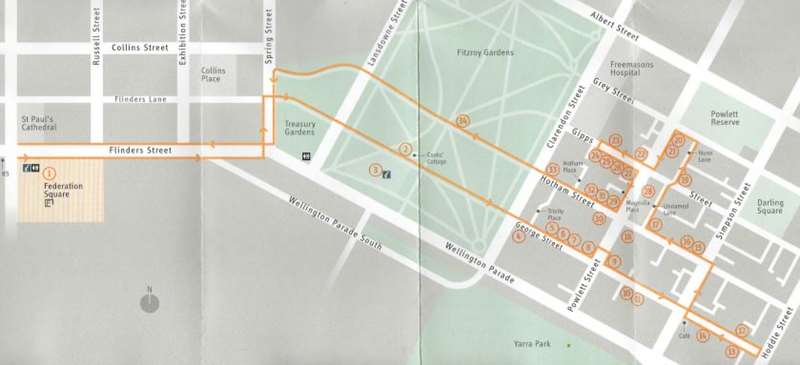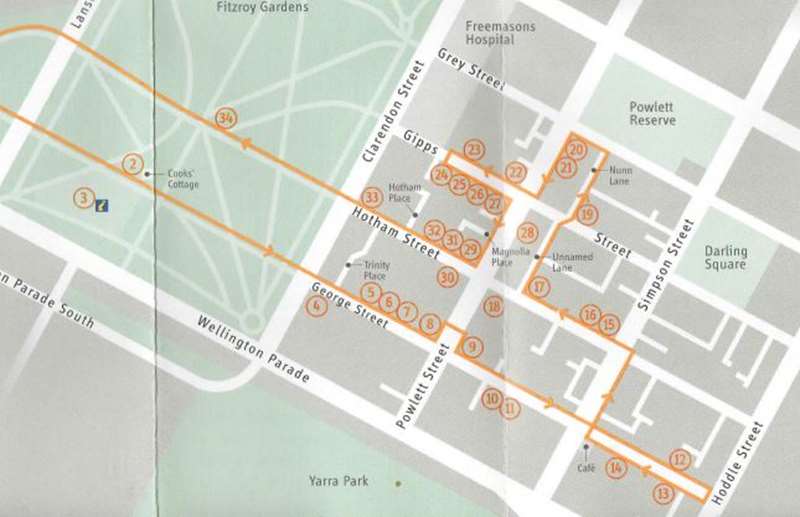Elegant Enclave Walk (Central Melbourne)

Take a 3km stroll from the city to East Melbourne and discover elaborate ironwork, classic columns and lofty verandas from the Victorian era.
Map of Walk Route

From Federation Square (1), walk or catch a free City Circle tram in an easterly direction from tram stop 5 to the corner of Spring Street and Treasury Gardens. Enter Treasury Gardens opposite Flinders Lane. Cross Lansdowne Street and continue straight ahead into the Fitzroy Gardens.
Pass the 1930 conservatory and Cooks' Cottage (2) on your left. The cottage, shipped from England, was the home of explorer James Cook's parents. Visit the Fitzroy Gardens Visitor Centre (3) for information services, merchandise and to speak with our friendly team.
Emerge from the gardens, cross Clarendon Street and continue east into George Street. Hepburn Terrace (No. 199-209) (4) was built in 1874 and is a fine example of the Victorian homes that define inner Melbourne. Two mansions opposite each other (No. 193 and 188) (5) have been beautifully restored.

One of East Melbourne's oldest homes is the 1856 terrace (No, 182) (6), while behind the hedge is gracious Braemar (No. 178) (7), dating to 1865 and nearly demolished in the 1970s.
On the corner of George and Powlett streets is a grand house that is now four apartments (8) Built in the 1860s and extended in the 1930s, it was home to Sir Benjamin Benjamin, Mayor of Melbourne in the 1880s.
Divert briefly left at Powlett Street for two neighbouring homes from the 1880s. Foynes (No. 52) and Eastcourt (9) have masses of iron lacework. Back on George Street, the house (No. 125b) (10) at the end of a drive was part of an early farm, while the Art Deco flats (No. 109) (11) were built in 1930.
When you see the George Street cafe, continue straight ahead on the street's left side before returning to the cafe via the other side. Along here are a converted 1920s post office (No. 24 ) (12); and Georgian Court (No. 21) (13), built as apartments in 1860; and the 1865 home of Melbourne's first surveyor, Robert Russell (No. 49) (14).
Turn right into Simpson Street to view magnificent Queen Bess Row (15) (cnr Simpson and Hotham streets). Built in 1886, it is three private homes.
Turn left into Hotham Street. Next to Queen Bess Row is Sydenham House (16), built in 1856 as a girls' school, while Dorset Terrace (No. 114-120) (17) has front doors unusually placed diagonally to the gates. Opposite is the former 1880s Cairns Memorial Presbyterian Church (18), converted into apartments after a fire in the 1980s.
Turn right into the lane next to Dorset Terrace. It is the back of magnificent Canterbury Terrace (seen later). Cross Gipps Street and continue into Nunn Lane, noting the Victorian home on the lane's right side with its contemporary addition (19).
Turn left into Grey Street and left again into Powlett Street. The 1868 home (No. 138) (20) has an unusual opera-box-style balcony. Like other houses along here, it looks two storied but, because of a slope, is three storeys at the rear. A few doors down, the house at No. 130 (21) was built in 1867.
The 1873 mansion (22) with the arched veranda, Crathre (corner Gipps and Powlett Streets), has been a private hospital and rooming house. Saved from demolition, it is a restored private home.
Divert right into Gipps Street for notable homes. No. 128-132 is Nepean Terrace (23). In 1888, it was the home of actor Frederick Baker who died on stage at the Princess Theatre and whose ghost, Federici, is said to haunt the theatre.
No. 179 (24) was the townhouse of Constance Stone, who became Australia's first woman doctor in 1890. Little Parndon, at No. 159 (25), was home to Eugene von Guerard, prominent artist and teacher in the late 1800s. At No. 155 (26), artist-author Norman Lindsay (who wrote The Magic Pudding) courted first wife Kate Parkinson in the 1890s. Behind the white wall, No. 107 Powlett Street (27) is the former home of Picnic at Hanging Rock author Joan Lindsay and husband Daryl Lindsay, once director of the National Gallery of Victoria.
Continuing on Powlett Street is Canterbury Terrace (No. 82-112) (28). Built in 1878, it is Melbourne's longest terrace, with 16 homes.
Pass by Magnolia Court which was Ormiston Ladies College. In the early 1900s, Magnolia Court was home to those involved in Melbourne's theatre and the early days of the Australian Ballet. Divert right into tiny Magnolia Place to discover the canopied back entrance of a mews house.
Back on Powlett Street, the terrace house at No. 85 (29) was home to Peter Lalor, who led miner's in the Eureka Stockade uprising at Ballarat in 1854.
Turn right into Hotham Street for the 1861 bluestone home (No. 157) (30) dubbed The Gothic House. It was designed by architect Joseph Reed (who designed Melbourne Town Hall, State Library and Royal Exhibition Building) for deputy surveyor-general Clement Hodgkinson (who designed the Fitzroy and Treasury gardens).
Opposite is Fairhall (No.154) (31), an elegant 1860 townhouse, now the home of The Johnston Collection (A beautiful house museum displaying an antique dealer's legacy of English and French antiques.).
Cyprus Terrace (No. 158-164) (32) was designed to look like two grand houses but is actually four homes. Look down Hotham Place to view the canopied front door of the same mews house of Magnolia Place.
Continuing on Hotham Street, hidden behind the long black fence is Bishopscourt (33), home to Anglican archbishops since built in 1853.
Head into the Fitzroy Gardens. Out front are the Fairies' Tree (34) by one-time East Melbourne sculptor Ola Cohn and the Model Tudor Village. Continue into Treasury Gardens before heading back to Federation Square.
Location
Cnr St Kilda Road and Flinders Street, Melbourne 3000 Map











